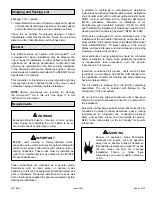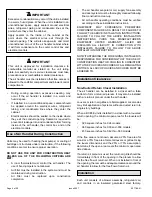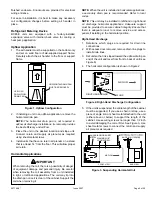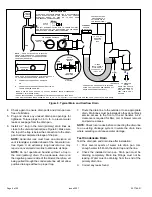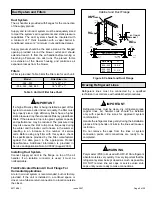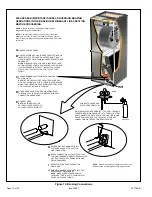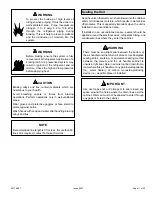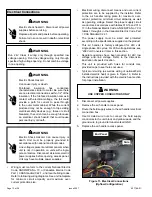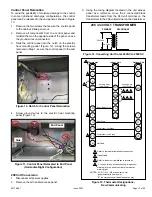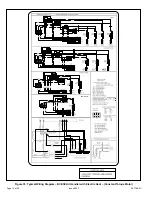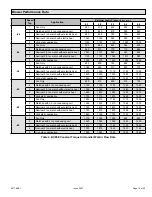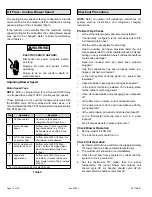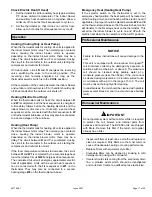
507788-01
Issue 2007
Page 17 of 20
Check Electric Heat (If Used)
1. Set thermostat to call for auxiliary heat (approximately
5°F above ambient temperature). The indoor blower
and auxiliary heat should come on together. Allow a
minimum of 3 minutes for all sequencers to cycle on.
2. Set the thermostat so that it does not call for heat.
Allow up to 5 minutes for all sequencers to cycle off.
Operation
Cooling (Cooling Only or Heat Pump)
When the thermostat calls for cooling, 24 volts is applied to
the indoor blower motor relay. The normally open contacts
close, causing the indoor blower motor to operate;
depending on the indoor blower motor, there may be a
delay. The circuit between
R
and
Y
is completed, closing
the circuit to the contactor in the outdoor unit, starting the
compressor and outdoor fan motor.
On heat pumps, circuit
R
and
O
energizes the reversing
valve, switching the valve to the cooling position. (The
reversing valve remains energized as long as the
thermostat selector switch is in the
COOL
position.)
At the completion of the cooling demand, the indoor blower
and outdoor unit should cycle off. Air handler should cycle
off 45 seconds after the outdoor unit shuts off.
Heating (Electric Heat Only)
When the thermostat calls for heat, the circuit between
R
and
W
is completed, and the heat sequencer is energized.
A time delay follows before the heating elements and the
indoor blower motor come on. Units with a second heat
sequencer can be connected with the first sequencer to
W
on the thermostat sub-base, or they may also be connected
to a second stage on the sub-base.
Heating (Heat Pump)
When the thermostat calls for heating, 24 volts is applied to
the indoor blower motor relay. The normally open contacts
close, causing the indoor blower motor to operate;
depending on the indoor blower motor, there may be a
delay. The circuit between
R
and
Y
is completed, closing
the circuit to the contactor in the outdoor unit, starting the
compressor and outdoor fan motor.
If the room temperature continues to decrease, the circuit
between
R
and
W1
is completed by the second-stage heat
room thermostat. Circuit
R-W1
energizes a heat sequencer.
The completed circuit will energize supplemental electric
heat (if applicable). Units with a second heat sequencer
can be connected with the first sequencer to
W1
on the
thermostat. They may also be connected to a second
heating stage
W2
on the thermostat sub-base.
Emergency Heat (Heating Heat Pump)
If the selector switch on the thermostat is set to the
emergency heat position, the heat pump will be locked out
of the heating circuit, and all heating will be electric heat (if
applicable). A jumper should be placed between
W2
and
E
on the thermostat sub-base so that the electric heat control
will transfer to the first-stage heat on the thermostat. This
will allow the indoor blower to cycle on and off with the
electric heat when the fan switch is in the AUTO position.
Professional Maintenance
Failure to follow instructions will cause damage to the
unit.
This unit is equipped with an aluminum Omniguard
TM
coil. Aluminum coils may be damaged by exposure to
solutions with a pH below 5 or above 9. The aluminum
coil should be cleaned using potable water at a
moderate pressure (less than 50psi). If the coil cannot
be cleaned using water alone, it is recommended to use
a coil cleaner with a pH in the range of 5 to 9. The coil
must be rinsed thoroughly after cleaning.
In coastal areas, the coil should be cleaned with potable
water several times per year to avoid corrosive buildup
(salt).
NOTICE
Homeowner Maintenance
Do not operate system without a filter. A filter is required
to protect the coil, blower, and internal parts from
excessive dirt and dust. The BCE5E units are shipped
with filters. Remove this filter if the return air register
already has a filter.
IMPORTANT
•
Inspect air filters at least once a month and replace or
clean as required. Dirty filters are the most common
cause of inadequate heating or cooling performance.
•
Replace filters with equivalent style filter.
•
Cleanable filters can be cleaned by soaking in mild
detergent and rinsing with cold water.
•
If water should start coming from the secondary drain
line, a problem exists which should be investigated
and corrected. Contact a qualified service technician.

